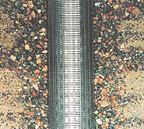Ideally, in order to obtain the most water possible from a screened well, the well would be installed as a perfect cylinder without any disturbance to the formation. This is not possible because a screen is needed to keep the formation from collapsing into the borehole. Therefore a 100 percent efficient screened well is not practical; however, some open hole wells completed in fractured rock may approach 100 percent efficiency.
The following steps can be taken to maximize screened well efficiency:
Drilling Method
Hollow stem augers or driven pipe that is retracted after a screen has been inserted inside an oversized casing are preferred drilling methods because fluids are not required to keep the borehole open. Smearing of the formation drilling occurs at the auger or casing and formation interface, however, the depth of smearing into the formation is minimal and easily restored during proper well development.Hollow stem augers or retractable oversize casings may not be feasible for large diameter or deep well installations. Drilling muds may then be required, but drilling muds are specifically designed to plug the permeable sections of the borehole and generally are difficult to remove during development.
Microscopically, the bentonite particles appear as flat plates that are held together with a gel. Additives such as polyphosphates assist in breaking down the gel for more effective mud removal. In addition, the drilling mud can be flushed deep into the formation where it is difficult to reach with the additives.
Organic drilling muds break down over time naturally and can be easier to remove from the borehole. Although they may produce a more efficient well, it takes experience to work with the organic drilling muds, and large volumes of these muds can be costly.

Size and Type of Screen
Well screens typically are slotted (saw cuts across the pipe) or wire wrapped. Both types of screens are available in PVC or stainless steel. Wire wrapped screens have a much larger percentage of open area which allows more water to flow into the well than slotted type screens. Although wire wrapped screens generally are recommended when maximum yield is desired, slotted pipe screens are much less expensive.The size of the slot or screen openings should be as large as possible but not so large that significant amounts of silt or sand continue to enter the well after the well has been developed. Although 0.010-inch slots are common for monitor wells, the yield can be increased greatly if the slot size is increased to 0.012 inches or 0.015 inches if the fine silts and sands can be developed out of the sand pack.
Speaking of the sand pack, if an artificial sand pack is chosen, the sand should be of uniform size, slightly larger than the screen slot size. Naturally developed sand packs are generally preferred if the screen is sized properly to allow only a small percentage of the smaller grains to enter the well during development. A sieve analysis usually is performed on a representative sample of the formation to determine optimum screen slot size.


Report Abusive Comment